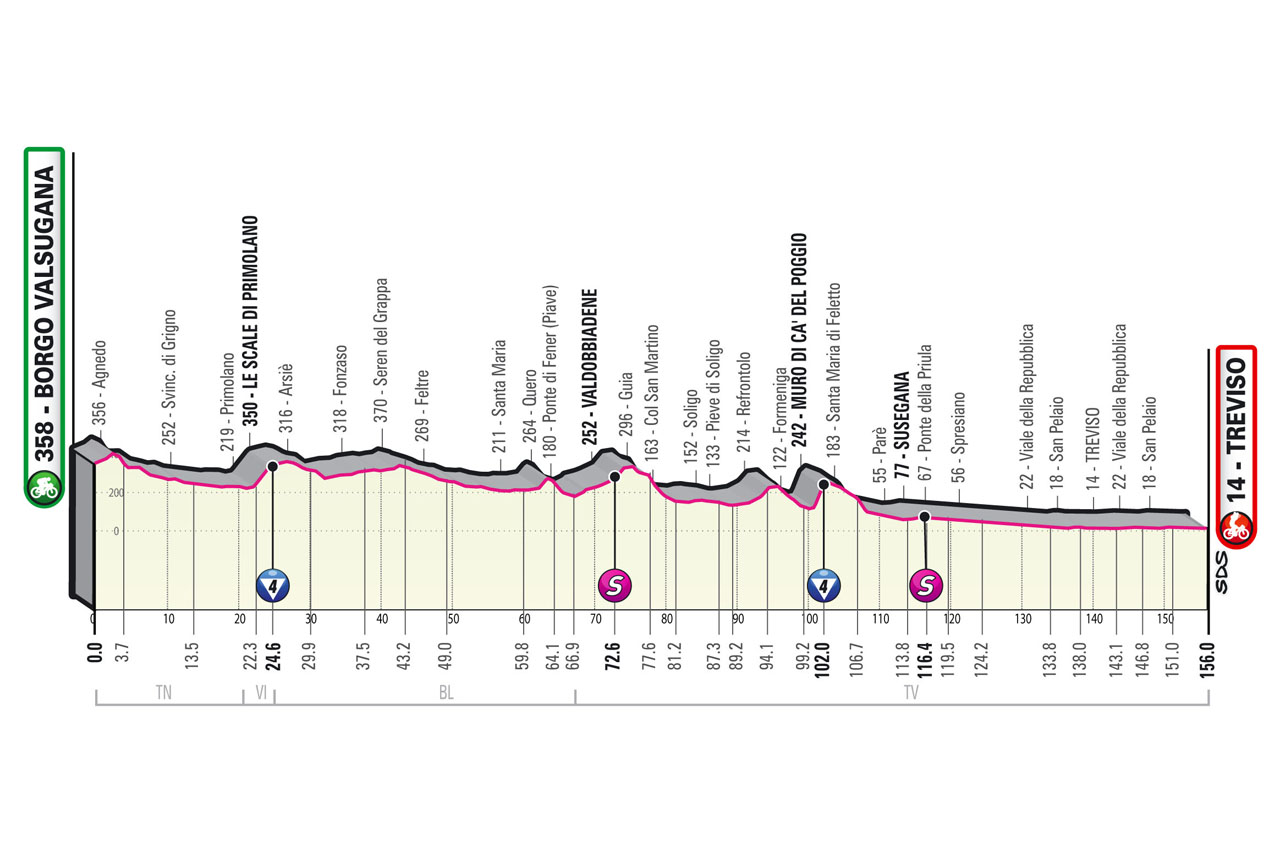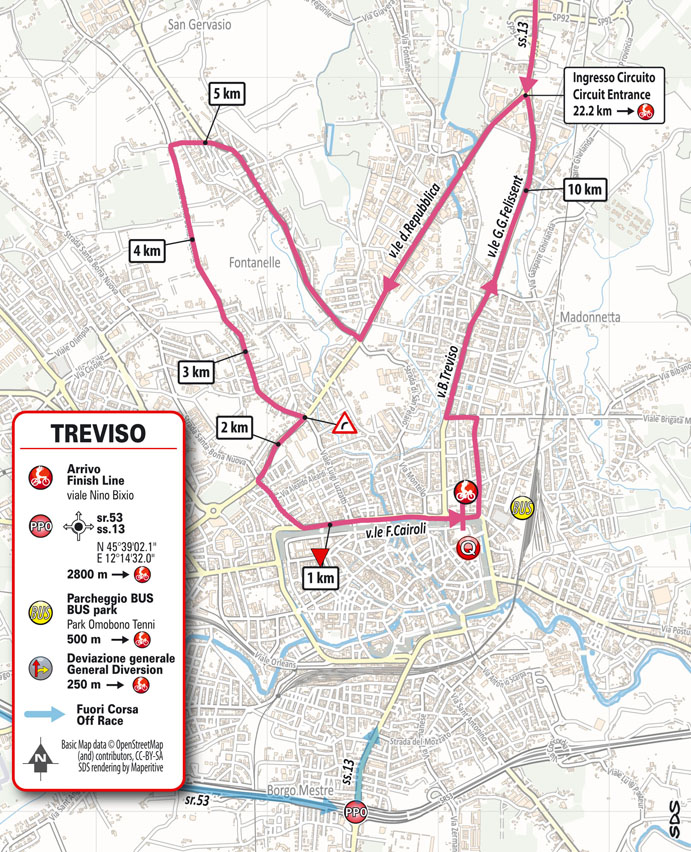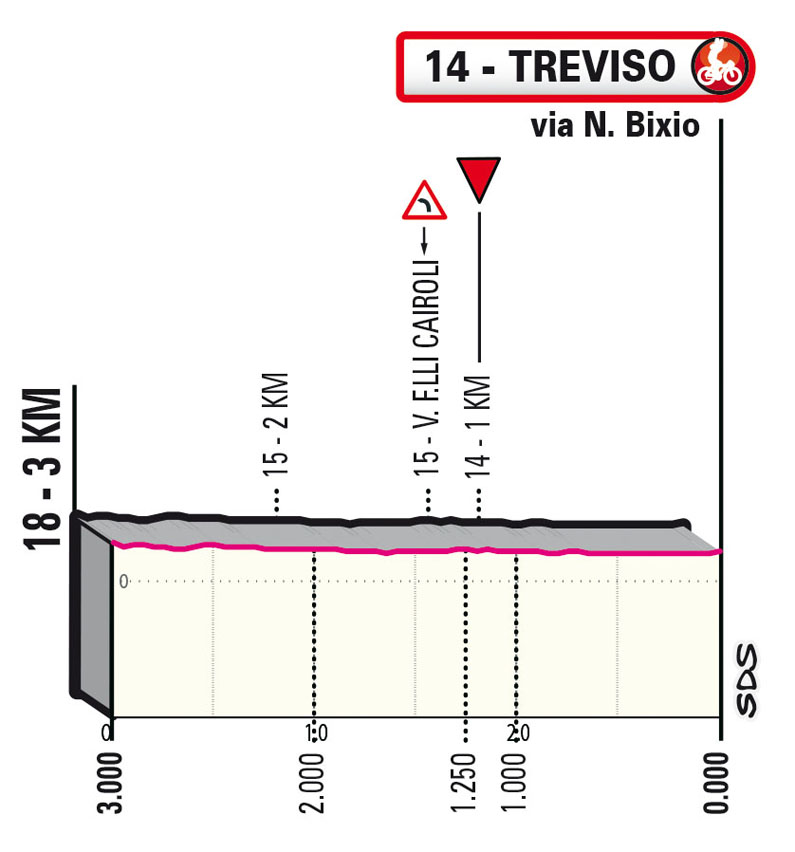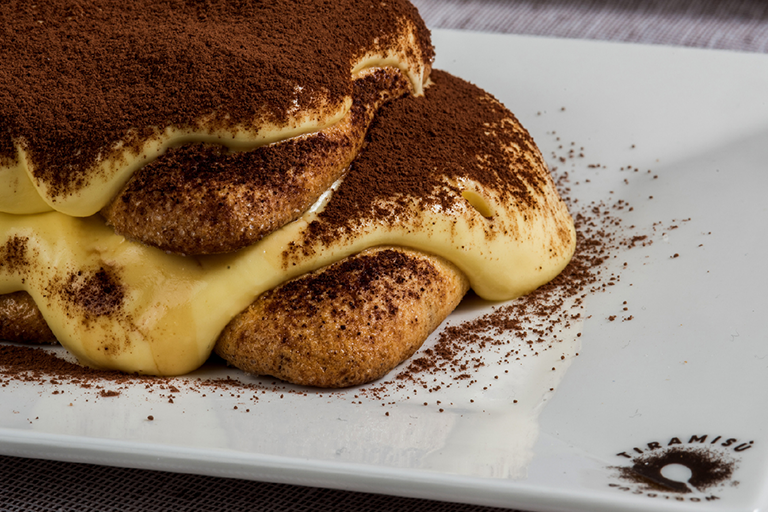profile
map
technical info
The route
The route connects the Valsugana and the Venetian Plain through the Scale di Primolano and the Muro di Ca’ del Poggio, the only topographical impediments of the stage, leading to Treviso along straight and usually wide roads. As the stage passes through several urban areas, roundabouts, traffic islands and street furniture will be found along the route. In Treviso, the riders will be met with a circuit of approx. 11 km, to be covered only once.
Final kilometres
The final circuit is played out on wide and flat roads, with the exception of a slightly narrower sector, from the ‑4 to the ‑2 km marker, and of a sharper corner with 3 km to go. Over the last 2 km, the road opens up, with just a final bend 1,200 m before the finish (on tarmac).
start / finish
climb detail
final kilometres
itinerary timetable
tourist info
Host city:
Borgo Valsugana
Touristic Information
The village is the only example in Trentino to be crossed by the river Brenta, also the classicism of the facades of the buildings along the Ausugum make it truly exclusive. The houses climb on the slopes of Mount Ciolino where stands the Telvana castle with its towers and, below, the convent of the cloistederd nuns. The town stretches along the sides of the old imperial road, while the new buildings expand towards the hamlet of Olle which still retains the characteristics of a rural village. The medieval character of Borgo has remained almost intact in its urban layout: streets, hallways, courtyards characterize it along with austere Renaissance and Baroque palaces.
Borgo Vals. is located in the center of the Valsugana, crossed by the beautiful cycle path of 80 km that connects Lake Caldonazzo to Bassano del Grappa. Also known as the seat of the famous cycling race “Coppa d’oro” Borgo and Valsugana valley offer many opportunities for lovers of the two wheels. From the great climbs of the Trentino “Passo Manghen”, “Vetriolo – Panarotta” and the famous “Menador” – the last two will be covered also during the 17th stage – to the 300 km of MTB trails of different difficulties along the Lagorai mountain chain. But summer in Valsugana is also beach on the Lakes of Levico and Caldonazzo or a spa relax thanks to the thermal spa of Levico and Vetriolo all with authentic hospitality in cozy and quality facilities.
Gastronomy
Food and wine tourism and sports tourism can now be a winning combination: in Valsugana-Lagorai you can discover typical Trentino products and local dishes with a strong flavor of tradition, authenticity and quality.
Where unspoiled nature and green pastures meet the culture and passion of healthy eating, here come on our tables the best mountain flavors. From polenta with the famous Valsugana flour to the genuineness of the small fruits of Sant’Orsola; from the excellent sausages to the local dairy products, such as the typical alpine cheese “Vezzena” and “Lagorai”. But also honey, the apples of Trentino, the radicchio of Bieno, the medicinal herbs of Valsugana , the chestnuts of Roncegno are transformed into truly unique dishes thanks to the magic touch of the people who take part in their processing.
In addition, in Valsugana-Lagorai the “Slow Food conduct” which aims to promote and safeguard the agri-food heritage of the territory: the good and healthy cuisine, here, is a treasure handed down from generation to generation.
Treat yourself to a break from the rule. Enjoy your holiday by tasting local food and wine products.
Beverages
L’acqua in Valsugana è un elemento primario. Acqua Levico nasce da una fonte centenaria dell’Alta Valsugana, ad oltre 1600 metri di altezza. La posizione della fonte e la presenza di un ambiente naturale incontaminato sono solo alcune delle ragioni della qualità di Acqua Levico. Grazie alle sue proprietà organolettiche è una delle acque da bere più leggere d’Europa. Acqua Levico nasce pura e così arriva sulla vostra tavola.
I pendii della Valsugana, assolati e dal clima mite, ben si prestano alle coltivazioni di uva che, grazie alla passione degli abili viticoltori si trasforma in ottimo vino. Distese di viti, specialmente di uva Chardonnay, adagiate sui dolci rilievi attorno al paese di Borgo Valsugana, offrono la materia prima a diverse cantine locali (Cantina Romanese, Cantine Cenci, Cantine Terre del Lagorai ) per produrre lo spumante TRENTODOC metodo classico. Vengono prodotti inoltre vini chardonnay, solaris e pinot nero.
L’alta qualità delle uve ed il complesso e delicato metodo della rifermentazione in bottiglia, fanno del TRENTODOC il fiore all’occhiello della produzione enologica trentina.
È grazie alla materia prima di alta qualità e ai fornitori locali che, a Borgo Valsugana, viene prodotta anche la birra artigianale trentina del Birrificio degli Arimanni. Ricerca, legame con il territorio, sostenibilità sono le parole chiave che caratterizzano un percorso che nasce dalla passione per la birra artigianale, passa attraverso la ricerca dell’eccellenza e si materializza in un prodotto genuino.
Ormai famoso per il suo gusto originale, il Parampampoli è una bevanda che riesce a riscaldare le fredde serate invernali e crea allegria durante le cene fra amici. La miscela segreta, inventata dall’oste del Rifugio “Crucolo”, ha un sapore forte che sa di caffè, grappa, vino e zucchero caramellato. Servito caldo e alla fiamma nelle caratteristiche tazzine del Rifugio è oggi una bevanda che identifica la Valsugana.
Bevanda di antica tradizione ottenuta dalla distillazione delle vinacce, la grappa non manca mai a fine pasto sulle tavole della Valsugana. La grappa valsuganotta viene prodotta con diverse aromatizzazioni con erbe e frutta locali: asperula, ruta, ginepro, mele, mirtillo, fragoline di bosco. Alla distilleria Vettorazzi viene anche prodotta la Stravecchia: una grappa invecchiata per diversi anni in piccole botti di rovere.
Main sights
Arte Sella
This is the international exhibition of contemporary art in nature that the Val di Sella has hosted since 1986. An immense open-air exhibition made of real works of art made with stones, leaves, branches and trunks. Arte Sella wants to be a creative process in which the work of each artist takes shape day by day on site, capturing from nature itself materials and inspirations.
At the end, many works find a new home in museums or art galleries, while others are left on site to integrate completely with the surrounding vegetation. The most well-known example to the public is the beautiful Vegetable Cathedral, which has become an icon of the event. Its majesty and beauty remains visible in every season: covered with snow is an even more impressive spectacle.
Sky Museum Borgo Valsugana
Arte Sella deals with the urban space of the village, creating a path of enhancement of the architectural and landscape qualities of the historic center of Borgo Valsugana with the realization of some artistic installations. Controfacciata by Edoardo Tresoldi is a series of four-metre high metal mesh volumes at the “Casa della Comunità”. The installation reveals the decorative features of four Renaissance-inspired aedicules. The Flying Man by Cédric Le Borgne is also made with metal mesh and is located near the Venetian bridge, placing the attention of the observer on the Brenta River and on the relationship with the horizon of the mountains, framed by the profiles of the houses of the historic center.
Castel Telvana
Ancient manor that dominates the valley since the twelfth century. It is reached through the Telvana staircase, which leads from Corso Ausugum to the Church of Saints Francis and Christopher. The oldest nucleus is located near the tower, resting on the primitive rock and inside you can admire the curtains that join the ramparts, now severed, that protected the residence. It can not be visited internally, but it can be reached with a beautiful mule track called the path of the castles and Bersaglieri Path starting from the center of Borgo.
The interior of the former Spagolla Mill, one of the most evocative river corners of the historic center of Borgo, houses the permanent exhibition of the First World War in Valsugana and the Lagorai which preserves the evidence of the Great War in our territory. In Olle you can visit the exhibition Soggetto Montagna Donna, set up at Casa Andriollo, which symbolically retraces the female journey through the centuries .
La Rocchetta is a small promontory just over 700 m high. located south of Borgo Valsugana. It has always played a natural function as a barrier located in the middle of the Valsugana and that is why, even during the war, it was used as a natural place of observation by both sides: both Italian and Austrian. The historic site of Rocchetta, open all year round with free entrance, can be reached by car, bike and bus in 5 minutes from Borgo Valsugana.
Not to be missed in Borgo Valsugana is the Corso Ausugum with its shops and cafés, the churches of S. Anna, the oratory of San Rocco, the Venetian bridge over the river Brenta and Palazzo Ceschi.
The Valsugana cycle path, which crosses Borgo Valsugana and connects Lake Caldonazzo with Bassano del Grappa, is a real paradise for all lovers of cycling: 80 km along which culture is intertwined, history and unique natural landscapes between Trentino and Veneto. Two regions linked by a path of water that has become a path of culture like the great European paths. The river Brenta and its course represent a unique itinerary characterized by historical, cultural and artistic aspects and natural of extreme interest, through territories rich in attractions. Its waters accompany you along an easy path, mostly flat, suitable for everyone to spend pleasant hours of freedom in the name of sport and contact with nature.
Activities and services
There are numerous rental and repair points where you can lean in case of need, while along the bike the Bicigrill serve as a refreshment point and information.
In Valsugana, there are many other interesting attractions to visit: starting from the First World War Forts such as Forte delle Benne and Forte Busa Granda up to Forte del Pizzo di Levico where you can enjoy a beautiful view of the high Valsugana and the lakes of Levico and Caldonazzo. Of historical importance and worth a visit are also the Castle of Pergine and Caste Ivano to Ivano Fracena.
Valsugana is also known as the birthplace of the great statesman Alcide Degasperi and on the Tesino Plateau, a few km from Borgo Valsugana, you can visit the Museo Casa Degasperi, set up in the birthplace of Alcide Degasperi who tells the story of Degasperi and Europe.
Treviso
Overview
Treviso is the historical capital of the Marca Trevigiana. Lying at the confluence of the Sile and Botteniga rivers, it is referred to as a “waterworld city”. Its many springs create a dense network of streams and canals that run across and around the city. The old town centre, located along the right bank of the Sile, dates from the Roman age. Piazza dei Signori is its beating heart. Treviso has a rectangular layout, with a maze of narrow alleys, lined with richly adorned houses, with porticoes and barbicans.
After surviving the Hun invasion, Treviso became a major commercial pole in the Roman age. It was later ravaged by the Hungarians, but eventually, it began thriving again. It was ruled by the Counts of Gorizia, by the Scaligers and by Venice, by Leopold of Austria, by the Da Carrara and the Visconti families, and once again by Venice. The city walls and gates provide evidence of the strong bond with the latter.
Later on, between the 18th and the 19th centuries, Treviso fell under the rule of Austria, the Kingdom of Italy, and Venice.
Treviso was bombed during both World Wars, and especially on 7 April 1944. On this fateful day, 159 Allied bombers destroyed 80% of the town’s buildings, taking a toll of at least 1,600 civilian casualties.
Treviso is a blend of history and grandeur, customs and passion, a city worth visiting for its stunning frescoed buildings, for its wealth of artistic heritage – on display at the civic museums – as well as for its popular restaurants, where traditional dishes are ubiquitous, along with Prosecco and the iconic bite-sized ‘cicchetti’.
Food
Local cuisine follow the excellent culinary tradition of Venice.
Below is a list of typical dishes, which combine the lovely flavours of seafood and land food.
Sopa coada is a hearty squab and bread soup, traditionally made from layers of bread, topped with grated cheese and boned wine-braised squab, which are then soaked in stock and baked for a few hours.
Pasta e fasioi is a staple of local cuisine. It is served as a thick soup made with creamed borlotti or Lamon beans, and ditalini pasta. Sometimes, a light mirepoix, or pork rind or cheek lard are used for added flavour. Traditionally, it is served on a layer of raw radicchio tardivo, and sprinkled with pepper.
Risotto with ‘rosoline’ is made with tender poppy leaves which are picked in the springtime, before the flowers bloom. The leaves are quickly blanched, and then eaten as a side dish, along with other leafy green vegetables, or used to make tasty risotto.
The most highly regarded typical products include tiramisù, radicchio and Prosecco, along with Casatella Trevigiana DOP (cheese) and asparagus.
Tiramisù is a layered dessert made from sponge fingers soaked in coffee, and a custard-like cream made with eggs, sugar and mascarpone cheese. The first known recipe, invented at Le Beccherie restaurant, dates back to 1962. The name of this dessert comes from the local vernacular expression “tirame su”, a reference to the uplifting effects of its ingredients.
The iconic ‘red’ radicchio first appeared in the 15th century. The winter varieties are grown by ‘forcing’ them after harvesting: left in the dark under tarps, the heads become crispier and tastier.
Casatella Trevigiana Dop is a fresh cheese that was traditionally made in farmers’ houses using the milk left over from direct human consumption. This cheese is soft and creamy, with a delicate scent of fresh milk and a sweet, slightly acidic taste.
Asparagus has been grown in the region since the Roman age. The stalks are ivory white, with hints of pink, and are used in flavourful traditional recipes such as risotto, or cooked ‘au gratin’, with morlacco cheese.
Beverage
Prosecco is the signature produce of the Alta Marca Trevigiana, and especially of the hills around Valdobbiadene. Here, halfway between the Dolomites and the Adriatic Sea, in a mild microclimate and on favourable soil, the finest Glera grapes are made into a balanced, characterful wine. Prosecco is an excellent pre-dinner sparkling drink. Covering a wide sweetness scale, from ‘brut’ to ‘dry’, it caters to a variety of different tastes.
Points of Interest
Treviso, the historical capital of the “Marca Gioiosa et Amorosa”, is known for the friendliness and the strong sense of belonging of its inhabitants. The town is a treasure chest of historical splendour, which includes the 16th century walls, the finely frescoed buildings, the iconic Fontana delle Tette (depicting a topless woman) and the traditional eateries.
Piazza dei Signori is one of the most popular landmarks, and the main hangout for the locals. It is the most exclusive part of the city, lined by historical public buildings such as the Palazzo del Podestà (including the civic tower) and Palazzo dei Trecento. The beautiful Loggia dei Cavalieri, nearby, has a finely decorated ceiling.
Departing from the central square, Via Calmaggiore, Via Palestro and the other main roads of the city are crowded with beautiful buildings, shops and traditional cafés and diners. If you’re in town, stop by one of the many typical eateries, and treat your taste buds to the specialties of local cuisine, paired with a glass of fine Prosecco. And at the end of the meal, taste the world’s best and most popular dessert, tiramisu – a favourite for date nights.
The Canale dei Buranelli is one of the most iconic landmarks, a perfect photo-op location and an oasis of peace, with beautiful arcades and bridges, clear waterways and a rich wildlife (mallards, moorhens, ducks and coots). The canal draws its name from a nearby palace that was the property of a merchant family from the island of Burano.
Wandering the streets of the town centre, you can admire the stunning, majestic architectures, and the finely frescoed buildings (13th-15th century) that have earned Treviso the name “Urbs picta”, which translates as “the painted town”.
Treviso is the home of one of the major museum hubs on a national level, which is headquartered in the Santa Caterina complex. Here, you can admire the beautiful “Storie di Sant’Orsola”, a cycle of frescoes by Tomaso da Modena describing the fashion at that time (one of the first ever). The Museo Bailo, located in the Borgo Cavour district, is the world’s largest collection of artworks by the local artist Arturo Martini, and by Italy’s leading impressionist painter, Gino Rossi.
Recently reopened, renovated and made digital, the “Collezione Salce” national museum, in Santa Margherita, is the world’s second largest collection of advertising posters after the one in Paris.
Treviso is home to one of the most beautiful theatres in northern Italy, named after the popular tenor “Mario Del Monaco”. The theatre has hosted performances by the greatest opera singers worldwide, and is currently a leading venue for world-class events, festivals and concert seasons.
Taking a gentle walk along the tree-lined avenues, you may admire the ancient city walls, built in the Roman age and later reinforced under the Republic of Venice. The imposing gates are still some of the most iconic landmarks of the city, such as Porta San Tomaso, built in 1518. The winged lion carved on the pediment testifies to the bond to Venice. The Sile flows nearby, making the place the perfect destination for easy jogs and bike rides.
Treviso is an excellent bike-friendly city, with a long pedestrian-cycle route – the “Rastera” – that runs along the Sile, through the nature, all the way to the sea, and bike hire points to enjoy the ride carefree.





















































































































